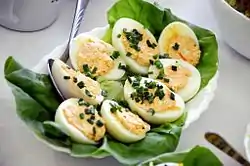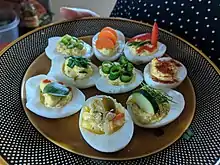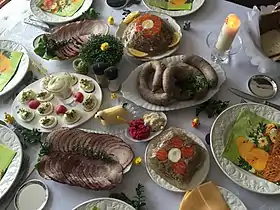Deviled egg
Deviled eggs (American English) or devilled eggs (British English), also known as stuffed eggs, Russian eggs, or dressed eggs, are hard-boiled eggs that have been shelled, cut in half, and filled with a paste made from the egg yolks mixed with other ingredients such as mayonnaise and mustard.[1] They are generally served cold as a side dish, appetizer or a main course, often for holidays or parties. The dish's origin can be seen in recipes for boiled, seasoned eggs as far back as ancient Rome, where they were traditionally served as a first course.[2][3] The dish is popular in Europe and in North America.
 A bowl of deviled eggs | |
| Alternative names | stuffed eggs, Russian eggs, dressed eggs |
|---|---|
| Course | Hors d'oeuvre |
| Place of origin | Italy |
| Region or state | Rome |
| Serving temperature | Cold |
| Main ingredients | Eggs, mayonnaise, mustard |
| Variations | Multiple |
| 200 kcal (837 kJ) | |
History
Recipes for hard-boiled eggs stuffed with herbs, cheese and raisins are known from the cookery texts of medieval European cuisine.[4]
Preparation and ingredients
Cooled hard-boiled eggs are peeled and halved lengthwise, with the yolks then removed. (They can be cut crosswise for more filling). The yolk matter is then mashed and mixed with a variety of other ingredients.[5] The classic recipe is made with egg yolks mashed with mayonnaise, dijon mustard, vinegar, pickle relish and salt and pepper.[4] The yolk mixture is then scooped into each egg "cup" made from the firm egg whites.
Ingredient choices vary widely and there is no "set" standard recipe. Although mayonnaise is most common, some recipes use butter, and sweet pickle relish sometimes replaces the sour pickles.[6]
Variations

There are many variations on the basic recipe that may add ingredients such as:
| Type | Ingredients | References |
|---|---|---|
| Bacon cheddar | Shredded cheddar, honey mustard, bacon | [7] |
| BBQ | Mustard, barbecue sauce, vinegar, garlic, onion, dill pickles, parsley | [8] |
| Caviar | Sour cream, lemon juice, fresh dill, caviar | [9] |
| Curry | Yogurt, curry powder, mustard, hot sauce | [10] |
| Fresh herbs | Mustard, chives, tarragon, parsley, paprika | [11] |
| Pesto | Basil or basil mint pesto | [12] |
| Shrimp | Sour cream, mustard, lemon juice, lemon zest, capels, dill, chopped shrimp | [13] |
| Southwestern deviled eggs | Chipotle chiles, adobo sauce, chile powder | [4] |
| Smoked salmon | Cream cheese, lemon juice, fresh dill, chives, capers, smoked salmon | [14] |
| Worcestershire-pecan | Worcestershire sauce, mustard, shallots, pecans, salt, pepper | [15] |
In different countries

In France, the dish is called œuf mimosa ("mimosa egg", named after the appearance of the mimosa tree[16]); in Hungary, töltött tojás ("stuffed egg") or kaszinótojás ("casino egg"); in Romania, ouă umplute ("stuffed eggs"); in Poland, jajka faszerowane ("stuffed eggs"); in the Netherlands gevuld ei ("stuffed egg"); in Sweden fyllda ägg ("stuffed eggs"); on the island of Malta bajd mimli ("stuffed eggs"). In parts of South America, it is called huevos a la peruana ("Peruvian eggs").[17]
In many European countries, especially Belgium, France, the Netherlands and Germany, a variation is served known as "Russian eggs". This consists of eggs cut in half, served with vegetable macédoine and garnished with mayonnaise, parsley and tomato.[18] Contrary to what the name might suggest, the dish does not originate in Russia; its name derives from the fact that the eggs are served on a bed of macédoine, which is sometimes called "Russian salad".
In Sweden, the deviled egg (Fyllda Ägghalvor) is a traditional dish for the Easter Smörgåsbord, where the yolk is mixed with caviar, cream or sour cream, optionally chopped red onion, and decorated with chopped chives or dill, perhaps with a piece of anchovy or pickled herring. In French cuisine, the other ingredients are most likely to be pepper and parsley. In Hungarian cuisine, the yolks are mashed and mixed with white bread soaked in milk, mustard and parsley, often served as an appetizer with mayonnaise, or as a main course baked in the oven with Hungarian sour cream topping and served with French fries. Other common flavorings of the yolks in German cuisine are anchovy, cheese and caper.
Deviled eggs are a common dish in the United States. In the Midwestern and Southern U.S., they are commonly served as hors d'oeuvres before a full meal is served, often during the Christmas season. Deviled eggs are so popular in the United States that special trays are sold specifically for serving them. Prepared and packaged deviled eggs are now available in some U.S. supermarkets. Deviled eggs are commonly served at Derby parties in Kentucky.
Etymology
The term "deviled", in reference to food, was in use in the 18th century, with the first known print reference appearing in 1786.[19] In the 19th century, it came to be used most often with spicy or zesty food, including eggs prepared with mustard, pepper or other ingredients stuffed in the yolk cavity. Similar uses of "devil" for spiced foods include deviled ham and fra diavolo (from the Italian word for "devil").
In parts of the Southern and Midwestern United States, the terms "stuffed eggs", "salad eggs", and "dressed eggs" are used instead. The term "angel eggs" has also been used in association with fillings with less fat and cholesterol.[20]
References
| Wikimedia Commons has media related to Deviled eggs. |
- Robert A. Palmatier, "Food: a dictionary of literal & nonliteral terms" Westport: Greenwood Press, 2000. p. 96
- Rebecca Katz (26 February 2013). The Longevity Kitchen: Satisfying, Big-Flavor Recipes Featuring the Top 16 Age-Busting Power Foods. Random House Digital, Inc. pp. 173–. ISBN 978-1-60774-294-4. Retrieved 18 March 2013.
- "The Ancient History of Deviled Eggs". Retrieved 21 August 2017.
- "Deviled eggs are hard to resist". The Republic from Columbus, Indiana. 31 December 2003. Retrieved 6 October 2020.
- The Art of Making Devilled Eggs (2008-08-08)
- "Heavenly variations on deviled eggs". The Journal Times from Racine, Wisconsin. 11 May 1998. Retrieved 7 October 2020.
- "Bacon cheddar deviled eggs". The Des Moines Register. 3 May 2017. Retrieved 7 October 2020.
- "Recipe: Barbecue Pit Deviled Eggs". The Seattle Times. 24 October 2007. Retrieved 6 October 2020.
- "Caviar deviled eggs". The Atlanta Constitution. 1 April 1999. Retrieved 7 October 2020.
- "Curried Deviled Eggs". Milwaukee Journal Sentinel. Retrieved 6 October 2020.
- "Make Herb Deviled Eggs for Easter". PBS. 24 March 2016. Retrieved 6 October 2020.
- "Pesto-Filled Deviled Eggs". The New York Times. Retrieved 7 October 2020.
- "Deviled eggs". The Modesto Bee. 28 April 2004. Retrieved 6 October 2020.
- "Smoked Salmon Deviled Eggs". The Washington Post. 15 April 2019. Retrieved 6 October 2020.
- "Recipe: worcestershire-pecan deviled eggs". Lincoln Journal Star. 19 July 2004. Retrieved 6 October 2020.
- "Oeufs mimosa". The Everyday French Chef. 13 April 2017. Retrieved 30 March 2018.
- "Huevos a la peruana con ensalada de tomates - Nova.cl - Toallas de Papel y Servilletas. Recetas de cocina y Menú Semanal". Retrieved 21 August 2017.
- "Oeufs à la russe – Les recettes de François". France 3 (in French). Archived from the original on 5 June 2010. Retrieved 11 July 2012.
- The Straight Dope: What's up with "deviled" eggs, ham, etc.? October 12, 2004.
- Collins, Richard, MD, FACC (29 March 2013). "Angel Eggs Not Deviled Eggs". The Cooking Cardiologist. Archived from the original on 26 July 2014. Retrieved 19 July 2014.
